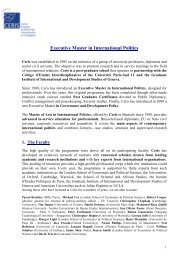hydropolitics of the tigris - euphrates river basin with - ceris.be
hydropolitics of the tigris - euphrates river basin with - ceris.be
hydropolitics of the tigris - euphrates river basin with - ceris.be
Create successful ePaper yourself
Turn your PDF publications into a flip-book with our unique Google optimized e-Paper software.
asic goods. In o<strong>the</strong>r words, Syria’s goal <strong>of</strong> self-sufficiency is moving far<strong>the</strong>r and far<strong>the</strong>r out <strong>of</strong> reach. This<br />
is complicated by <strong>the</strong> poor quality <strong>of</strong> oil that Syria produces, requiring it to also import a certain amount <strong>of</strong><br />
processed oil from Iraq and Saudi Arabia. Recent natural gas finds may supplement this export balance in<br />
<strong>the</strong> future but <strong>the</strong> situation for feeding its own population has <strong>be</strong>en so tenuous that Syria has had to accept<br />
Food Aid in 1990 and 1997. Presently Syria must import <strong>be</strong>tween one-third and one-half <strong>of</strong> its cereal needs.<br />
It is not surprising that <strong>the</strong> Euphrates Rivers is <strong>the</strong>ir primary focus for development, irregardless <strong>of</strong> its more<br />
powerful neighbours who command its sources (Turkey) or insist on its continuing supply (Iraq). 29<br />
Syria has launched a num<strong>be</strong>r <strong>of</strong> water and hydro-electric power development schemes to regain its goal <strong>of</strong><br />
self-sufficiency. In 1974, <strong>with</strong> <strong>the</strong> aid <strong>of</strong> Soviet engineering and finance, Syria constructed <strong>the</strong> Tabqa Dam<br />
on <strong>the</strong> Euphrates, forming <strong>the</strong> giant reservoir later named Lake Assad. As expected <strong>the</strong>re were conflicting<br />
complaints and relations from downstream Iraq. With expectations <strong>of</strong> up to 60% <strong>of</strong> <strong>the</strong> nation’s hydro-power<br />
production and irrigation <strong>of</strong> almost 400,000 hectares from <strong>the</strong> Tabqa, <strong>the</strong> results were disappointing. Some<br />
<strong>of</strong> <strong>the</strong> generators were faulty and affected by seasonal variations <strong>of</strong> discharge, producing as little as 150 MW<br />
as opposed to <strong>the</strong> expected 840 MW. The land to <strong>be</strong> irrigated turned out to contain a large component <strong>of</strong><br />
gypsum in its soil structure, a mineral composed <strong>of</strong> calcium sulphate that <strong>be</strong>came soluble in water and<br />
dissolved. The region to <strong>be</strong> irrigated had <strong>be</strong>en levelled at much expense to promote irrigation flow but it<br />
soon dissolved into a vast field <strong>of</strong> holes and hummocks, breaking canal structures, causing leakage and<br />
making regulated flow impossible. The dissolved gypsum also adversely affected crops in <strong>the</strong> <strong>the</strong>ir root<br />
zone. 30 The Syrian Government <strong>be</strong>gan revising downwards its estimates <strong>of</strong> irrigable land to 370,00 ha<br />
(hectares) and later to 240,000ha. Estimates <strong>of</strong> <strong>the</strong> real situation are vague, ranging from 60,000 ha to almost<br />
400,000, although <strong>the</strong> latter figure is unlikely as it is higher than <strong>the</strong> Syrian government’s estimate. 31<br />
O<strong>the</strong>r dams have <strong>be</strong>en constructed by Syria in <strong>the</strong> Euphrates Valley, including <strong>the</strong> Al-Baath regulatory dam<br />
and <strong>the</strong> Tishreen hydro-electric power dam. Syria has future plans for irrigation water to <strong>be</strong> drawn from <strong>the</strong><br />
Tigris (from which it has access to only one bank) and on <strong>the</strong> Orontes River. The latter is a cause <strong>of</strong> irritation<br />
<strong>with</strong> Turkey who is in this case a downstream user from Syria. Additional plans for future irrigation arrive at<br />
a global target <strong>of</strong> 1.4 million hectares, which will require considerably more abstraction from <strong>the</strong> Euphrates<br />
and <strong>the</strong> Tigris Rivers than is <strong>be</strong>ing developed at <strong>the</strong> moment. Considering <strong>the</strong> abstraction planned for<br />
Turkey’s GAP, this may not <strong>be</strong> realistic, but again this is difficult to say <strong>be</strong>cause accurate data on Syria’s<br />
water resources are extremely elusive. The absence <strong>of</strong> hard data, according to many observers, reflects a lack<br />
16





